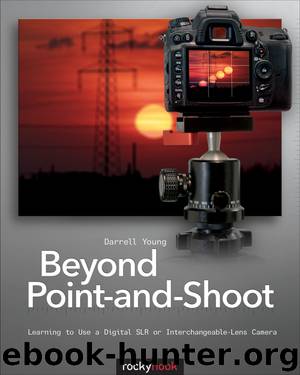Beyond Point-and-Shoot by Darrell Young

Author:Darrell Young
Language: eng
Format: epub
Publisher: Rocky Nook
Published: 2012-08-28T16:00:00+00:00
Figure 4.9: Three people at f/22, shutter speed 1/40s, ISO 100 = a deep depth of field
If I had been using manual mode instead of aperture priority, I would have had to adjust both the aperture and the shutter speed myself. Aperture priority made it easier for me by adjusting the shutter speed automatically when I changed the aperture. I like semiautomation because it works very well in today’s cameras. We’ll talk more about semiautomation in the next chapter.
The pictures in this section were fairly easy to take under sunny skies with stationary subjects, but you can see where shutter speed exposure compensations could get troublesome if these three subjects had been playing ball or jumping around, because 1/40s will not stop action very well.
This is when experienced photographers take advantage of motion control (later in this chapter) and become less concerned about depth of field. Sometimes you have to make a trade-off (speed over depth). When you want to freeze action, depth of field cannot take absolute priority because the slow shutter speed that results from a small aperture will not stop action. The emphasis must switch from aperture control to shutter speed control. Shutter speed provides motion control.
Tip: I could have used manual mode to take the pictures in this section by setting the aperture and shutter speed manually, but I’m a believer in using technology to help myself when it is appropriate to do so. I controlled what I wanted to control—the aperture—and let the camera save me time by automatically adjusting the shutter speed. My purpose was to effectively control and extend the depth of field in these three images by using the aperture (depth of field control), not the shutter speed (motion control). I was not overly concerned about the shutter speed, except the speed of 1/40s in figure 4.9. That shutter speed is slow for the lens I used, so my picture could have started getting blurry from camera vibrations. Please refer to the upcoming section called “Reciprocal of Focal Length Shutter Speed Rule” to gain a better understanding of why you have to pay careful attention to shutter speed when handholding your camera.
ASSIGNMENT:
Set your camera to ISO 800 and aperture priority mode (A or Av). Take a picture of an outdoor subject with your camera’s largest aperture opening (f/1.4 to f/4) as close as your lens will focus. Include some background, and use a large aperture for a shallow depth of field to make the background look blurry. If you are using a kit lens with a maximum aperture of f/3.5, it will be a little harder to blur the background, but if you get close to your subject, the background will blur. Now, shoot a second picture of the same subject at your lens’s minimum aperture (usually f/22). Compare the two pictures on your computer monitor at 100 percent. Pay careful attention to how the depth of field difference between the maximum and minimum apertures affect the subject and the background. Does
Download
This site does not store any files on its server. We only index and link to content provided by other sites. Please contact the content providers to delete copyright contents if any and email us, we'll remove relevant links or contents immediately.
| Color | Darkroom & Processing |
| Digital Editing | Equipment |
| Flash Photography | Handbooks & Manuals |
| Lighting | Reference |
Shoot Sexy by Ryan Armbrust(17637)
Portrait Mastery in Black & White: Learn the Signature Style of a Legendary Photographer by Tim Kelly(16933)
Adobe Camera Raw For Digital Photographers Only by Rob Sheppard(16881)
Photographically Speaking: A Deeper Look at Creating Stronger Images (Eva Spring's Library) by David duChemin(16599)
Bombshells: Glamour Girls of a Lifetime by Sullivan Steve(13952)
Art Nude Photography Explained: How to Photograph and Understand Great Art Nude Images by Simon Walden(12954)
Perfect Rhythm by Jae(5305)
Pillow Thoughts by Courtney Peppernell(4188)
The Book of Joy by Dalai Lama(3882)
Good by S. Walden(3468)
The Pixar Touch by David A. Price(3344)
A Dictionary of Sociology by Unknown(2998)
Fantastic Beasts: The Crimes of Grindelwald by J. K. Rowling(2975)
Humans of New York by Brandon Stanton(2814)
Stacked Decks by The Rotenberg Collection(2796)
Read This If You Want to Take Great Photographs by Carroll Henry(2653)
On Photography by Susan Sontag(2562)
Insomniac City by Bill Hayes(2477)
Photographic Guide to the Birds of Indonesia by Strange Morten;(2476)
